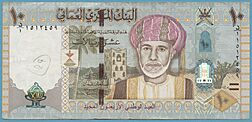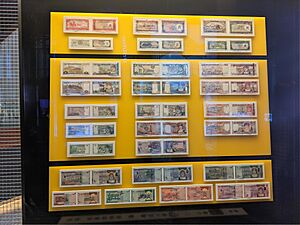Omani rial facts for kids
Quick facts for kids Omani rial |
|||
|---|---|---|---|
|
|||
| ISO 4217 Code | OMR | ||
| User(s) | |||
| Inflation | 4.1% | ||
| Source | The World Factbook, 2011 est. | ||
| Pegged with | US dollar (USD) 1 OMR = 2.6008 USD (exact) 1 USD = 0.384497 OMR (approx.) |
||
| Subunit | |||
| 1⁄1000 | baisa | ||
| Symbol | ر.ع. R.O or ﷼ | ||
| Coins | |||
| Freq. used | 5, 10, 25, 50 baisa | ||
| Banknotes | |||
| Freq. used | 100 baisa, 1⁄2, 1, 5, 10, 20, 50 rials | ||
The Omani rial (OMR) is the official money used in Oman, a country in the Middle East. It is divided into 1000 smaller units called baisa. This means 1 rial is worth 1000 baisa.
Contents
How the Omani Rial Works
The Omani rial is one of the most valuable currencies in the world. It is currently the third-highest-valued currency unit, after the Kuwaiti dinar and the Bahraini dinar.
Rial's Value Against the US Dollar
Since 1986, the Omani rial has been linked to the U.S. dollar. This means its value is kept stable against the dollar. One Omani rial is always worth about US$2.6008. This fixed rate helps keep the economy stable. The Central Bank of Oman manages this exchange rate.
History of Oman's Money
Before the Omani rial, different types of money were used in Oman. Understanding this history helps us see how the country's currency developed.
Early Money in Oman
Until 1940, people in Oman mainly used the Indian rupee and a silver coin called the Maria Theresa thaler. The thaler was often called "rial" because it looked similar to the Spanish eight-real coin. Indian rupees were used more along the coast, while thalers were common inland.
First Omani Coins
In 1940, Oman started making its own coins for use in Dhofar. These coins were in units of baisa, which was like the paisa. Later, in 1946, more coins were made for use across Oman. At this time, 200 baisa made 1 rial. The Indian rupee and later the Gulf rupee were still used alongside these new coins.
The Saidi Rial and Omani Rial
In 1970, a new currency called the Saidi rial was introduced. It replaced the Gulf rupee. The Saidi rial was linked to the British pound sterling. Then, in 1972, the Omani rial replaced the Saidi rial. At this point, the Omani rial became linked to the U.S. dollar instead of the pound sterling. The name of the currency changed because the country's name also changed around that time. Since 1975, new coins have been issued with the country's name simply as Oman.
Coins Used in Oman
Oman has issued many different coins over the years. Today, certain coins are used more often than others.
Coins in Circulation Today
Currently, the coins you will most commonly see are 5, 10, 25, and 50 baisa. Older coins, like those for 100 baisa or more, lost their value on May 20, 2020.
Coins from 1975
The 1975 series of coins featured Sultan Qaboos bin Said on one side. The other side showed the coin's value and the year it was made. These coins were made from bronze, copper-clad steel, copper-nickel, or nickel-plated steel.
| Sultan Qaboos issue (1975) | |||||||
|---|---|---|---|---|---|---|---|
| Value | Diameter (mm) |
Mass (g) |
Composition | Edge | Obverse | Reverse | Issue |
| 5 baisa | 19 | 3.11 | Bronze | Smooth | National emblem; Lettering: Qaboos bin Said, Sultan of Oman |
Denomination in Arabic; Year of issue in Hijri and Gregorian |
1975 |
| 5 baisa | 19 | 2.65 | Copper-clad steel | 1999 | |||
| 10 baisa | 22.5 | 4.76 | Bronze | 1975 | |||
| 10 baisa | 22.5 | 4.1 | Copper-clad steel | 1999 | |||
| 25 baisa | 18 | 3 | Copper-nickel | Reeded | 1975 | ||
| 25 baisa | 18 | 2.63 | Nickel-plated steel | 2008 | |||
| 50 baisa | 24 | 6.4 | Copper-nickel | 1975 | |||
| 50 baisa | 24 | 5.57 | Nickel-plated steel | 2008 | |||
| 100 baisa | 21.5 | 4.20 | Copper-nickel | National emblem; Lettering: Sultanate of Oman; Year of issue in Hijri and Gregorian |
Lettering: Central Bank of Oman and value | 1984 | |
| 1⁄4 riyal | 26 | 6.5 | Aluminium bronze | Lettered | 1979 | ||
| 1⁄2 riyal | 30 | 10 | Aluminium bronze | Reeded | |||
Coins from 2020
A newer series of coins was released in 2020. These coins feature Sultan Haitham bin Tariq.
| Sultan Haitham issue (2020) | |||||||
|---|---|---|---|---|---|---|---|
| Value | Diameter (mm) |
Mass (g) |
Composition | Edge | Obverse | Reverse | Issue |
| 5 baisa | 19 | 2.64 | Copper-clad steel | Smooth | National emblem; Lettering: Haitham bin Tariq, Sultan of Oman |
Denomination in English and Arabic; Year of issue in Hijri and Gregorian |
2020 |
| 10 baisa | 22.5 | 4.08 | |||||
| 25 baisa | 18 | 2.65 | Stainless steel | Reeded | |||
| 50 baisa | 24 | 5.55 | |||||
Banknotes of Oman
Oman has issued many different banknotes over the years, with new designs and security features added regularly.
History of Banknotes
The Sultanate of Muscat and Oman first issued banknotes in 1970. These included values like 100 baisa and up to 10 rial saidi. In 1972, the Oman Currency Board took over, issuing notes for the Omani rial.
Since 1977, the Central Bank of Oman has been in charge of issuing banknotes. They introduced higher value notes like 20 and 50 rials. New series of notes have been released over the years, often to celebrate national events or to update designs. For example, special 1-rial notes were issued in 2005 and 2015 to mark National Days.
Current Banknotes
As of January 1, 2025, all banknotes issued before 2020 are no longer valid. This means you cannot use them for payments or exchange them at banks. The newest series of banknotes, released in 2020, are the ones currently in use. These notes feature Sultan Haitham bin Tariq on one side.
Banknotes from 2020 (Sixth Issue)
This is the most recent series of banknotes. They feature important Omani landmarks and symbols.
| Sixth issue (2020) | ||||||
|---|---|---|---|---|---|---|
| Value | Dimensions (mm) |
Main colour | Obverse | Reverse | Date of issue | |
| 100 baisa | 122 x 64 | Brown | National emblem; Jebel Akhdar terraces |
Falaj Al-Jeela; Coconut trees and palm groves |
2021 | |
| RO 1⁄2 | 136 x 64 | Green | National emblem; Ain Khor and frankincense |
Arabian leopard and sooty falcon | ||
| RO 1 | 146 x 76 | Red | National emblem; Oman Across Ages Museum |
Khasab Castle, Wadi Al-Ayn tombs, Jirz axe, Omani khanjar |
||
| RO 5 | 153 x 76 | Pink | Haitham bin Tariq; Sultan Qaboos University |
Royal Opera House Muscat | ||
| RO 10 | 160 x 76 | Beige | Haitham bin Tariq; Sultan Qaboos Grand Mosque |
Al-Baleed Great Mosque; Niche of al-Uweyna Mosque |
||
| RO 20 | 167 x 76 | Blue | Haitham bin Tariq; Muscat International Airport |
Batinah Expressway; Salalah International Airport; Sohar Industrial Port |
||
| RO 50 | 174 x 76 | Green | Qaboos bin Said; Central bank building |
Council of Oman; Ministry of Finance; Supreme Court |
2020 | |
Related Topics
- Oman
- Economy of Oman
- Gulf Cooperation Council
- Saudi riyal
- Yemeni rial



